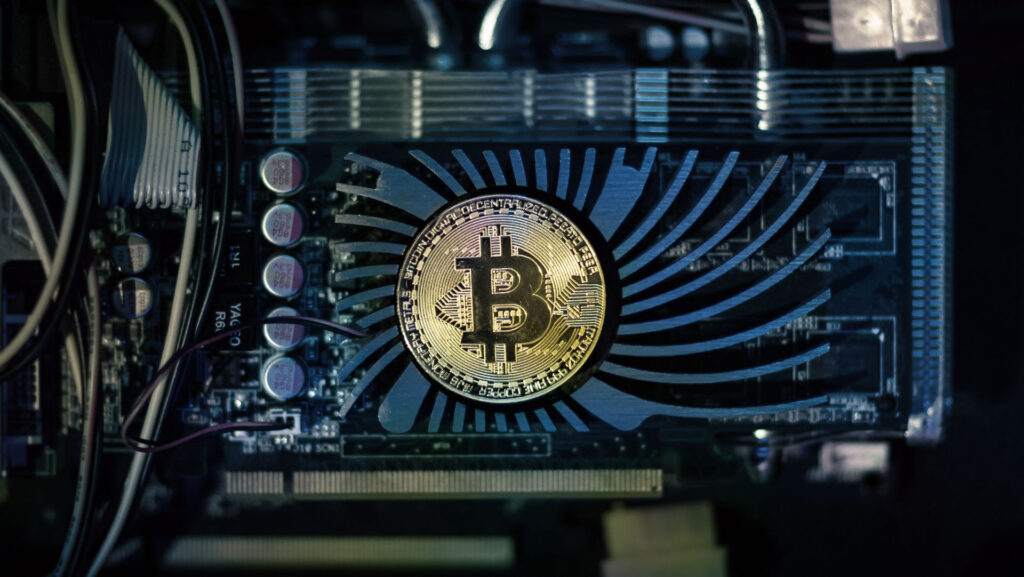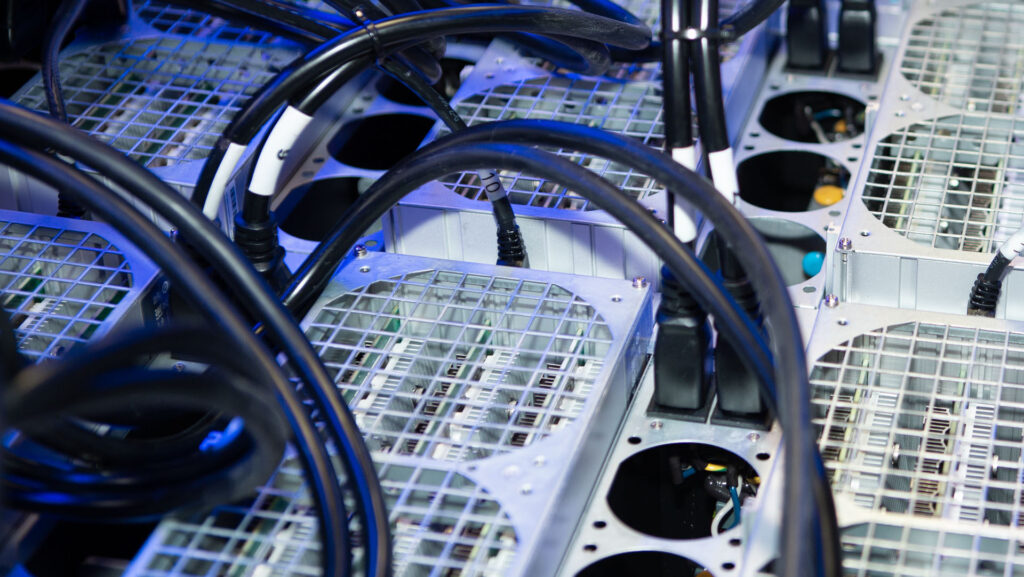If you’re just getting started in the world of cryptocurrency mining, or you need to educate a colleague on how crypto mining works, this blog is the place to start. Everyone is aware of what cryptocurrencies are and the potential they have for investors and for those willing to mine the currency. In this blog, we’ll explain how it works and where the mining industry is headed.
The cryptocurrency mining process
Investopedia describes cryptocurrency mining as a form of auditing – and the term “mining” is actually somewhat misleading. Crypto miners are, in fact, working to validate the transactions that take place on the cryptocurrency’s network by creating valid blocks of those transactions (these are the blocks that form the blockchain – but more on that later). Miners create those blocks by correctly guessing a hash (a 64-digit hexadecimal number) that is equal to, or lower than, a target hash that the cryptocurrency network has set for that new block. To create that new hash, the miner has to include the hash from the previous block – which means that every new block validates the previous block. Incidentally, that’s how the blockchain concept works. Each new block includes all the information from the entire chain before it, creating a record of transactions that is very difficult to spoof.
To borrow another term from cybersecurity, mining is essentially a form of brute-forcing – miners are randomly guessing new hashes until they find the right one for the new block. If a miner finds the correct hash for a new block of transactions, that block is created, and the miner is awarded new bitcoin.
A step-by-step process for crypto mining
- A miner gets information on the latest new block added to the blockchain
- The miner creates a block template that includes the hash of that new block and starts adding nonces (smaller numbers used to create new hashes) to that template to try and produce a valid hash.
- At the same time, the miner regularly updates the template to include fresh transactions in the block it’s trying to create.
- If the miner finds a valid hash for the next block before anyone else, the block is created, and the miner is awarded bitcoins
- If two miners arrive at a solution simultaneously, the network votes on which one to honor – and generally, it favors the minor that has validated the most transactions.

Why mine cryptocurrency?
There are two reasons for crypto mining. Firstly, it’s essential for keeping cryptocurrencies operational. Secondly, it has the potential to be lucrative. Let’s look at those in turn.
Why is mining essential for a cryptocurrency to work?
Cryptocurrencies are decentralized – there is no authority that regulates them, controls them, or validates transactions. Instead, this work is done by nodes (computers running the cryptocurrency’s associated software) on the network. Miners are, essentially, a type of node, and their job is to validate transactions.
Without miners, there would be nobody to validate a cryptocurrency’s transactions, and the system would be completely unworkable. That’s why miners are rewarded for their work – which is what makes mining (potentially) a great way to make money.
How do you make money mining cryptocurrency?
There are two ways you make money as a miner. Firstly, miners that find valid hashes for new blocks are rewarded with some of the cryptocurrency by the system (note that the “coins” the miners receive are not actually a part of the hash but awarded by the system – again, the mining is figurative, not literal). This is known as the block reward. Secondly, the transactions that are validated in each block contain a transaction fee, which the miner that creates the block gets. It’s worth noting that the creation of new coins is another way the miners support the network by helping new currency circulate.
At present, the block reward is far larger than the transaction fees miners receive, making it the main incentive for mining. However, due to the finite number of coins in any cryptocurrency, the reward for finding new block halves roughly every four years (for instance, in Bitcoin, the current reward is 6.25BTC). But more on that later.
The rewards of crypto mining mean that lots of individuals and organizations want to mine cryptocurrencies as a way of making money. While this is good for the currency as it ensures there are plenty of people to validate transactions, it’s also part of the reason why mining crypto uses so much power and is, therefore, expensive.
Why does crypto mining use so much power?
You’re a crypto miner, so you know that mining cryptocurrency requires a LOT of computing power. But why does it need all that power? The answer all stems from the popularity of mining and the need for a consistent rate of block creation in any crypto network.
Most cryptocurrencies create new blocks at regular intervals in order to efficiently process transactions – which means that they need miners to find the correct hashes to create those new blocks at regular intervals. As more and more miners join a cryptocurrency network, competition to find the next block increases – everyone wants to find the block and get the reward. To beat that competition, miners are always trying to increase the speed with which their machines can guess hashes – the hashrate, as it’s known. The best mining technology is now computing up to 1.77 terahashes per second (or 1.7 TRILLION hashes every second).
That competition was causing a problem: as miners got faster and faster at guessing hashes, cryptocurrency networks found that the new blocks were being created too soon. To combat this, crypto networks periodically increase (or decrease, if the rate of competition ever falls) the difficulty of finding the next hash in order to keep the rate of block creation stable. So alongside competition from other miners, the network itself is making it harder to find the next hash – meaning you need more computing power if you want to find it first.
Of course, all this computing power uses a lot of electricity not just to run the machines but to keep them cool (which is vital unless you want your miners to catch fire!). That’s one reason why liquid immersion cooling is becoming so popular for miners.
Will cryptocurrency be reduced over time?
Yes – and no. Each cryptocurrency has a finite number of coins that can be mined. This creates challenges for the currency – specifically, a lack of inflation. To stimulate inflation, after a specific number of blocks have been mined, the reward for mining new blocks is halved.
These events, unsurprisingly, halve the rate at which new currency is released into circulation. This is designed to create scarcity, and so drive up the price of the currency, protecting the incentive for miners to continue their work (because they are getting fewer blocks, but those blocks are worth more) and keeping the currency attractive as an investment.
So, empirically, no – there will always be the same amount of cryptocurrency around. But the rate at which new coins enter circulation will continue to slow and eventually will stop altogether. For Bitcoin, it’s estimated that the last coin will be mined in 2140.
As a miner, you might be worried by this – after all, if the block reward is the main source of income for a miner, then over time, you will see diminishing returns for your efforts. Given the already large costs of the hardware, power, and cooling that mining takes, this could render your operation unprofitable. So, what do you do?
It’s a challenge that many miners are struggling with, and there’s no denying that the decreasing block reward is threatening some miners. However, as the block reward falls, it is expected that the transaction fees users pay will rise to compensate. Because cryptocurrencies are decentralized, there is no governing body setting transaction fees. Instead, users decide on their own transaction fees, and miners are free to choose which transactions to validate in their blocks based on transaction fees. So, essentially, users of cryptocurrencies will find that they need to pay higher fees to encourage miners to validate their transactions, and in this way, the average transaction fee will rise.
The future of cryptocurrency mining
As we’ve just discussed, every cryptocurrency will face the same future – halvings will continue until all the coins have been mined. So, every cryptocurrency will see a shift in how miners are compensated, from block rewards to transaction fees. The rate at which this will happen will vary depending on the currency in question. Beyond this, we see the following trends in the future that may impact the activities of miners:
Cryptocurrency regulations coming to the fore
In 2023 it’s expected that many debates about how cryptocurrencies should be regulated will come to a boiling point. That includes how nation-states regulate cryptocurrency and mining but also debates within networks themselves about how to organize themselves. These developments (especially proof of stake, as we cover below) may well affect your mining operation.
Crypto adoption globally could rise
Though many nations are cautious about cryptocurrencies, others – especially in the developing world – are more optimistic. If cryptocurrencies gain more traction and popularity in these countries, the opportunities for miners could well grow.
Web3 may cause a rise in demand for miners
Web3 is a concept for the next iteration of the World Wide Web that focuses heavily on decentralization and blockchain technologies to function. Though its applications go well beyond cryptocurrencies, the mining process may well remain in demand as a way to validate other blockchains, with alternative reward structures set up to make the process profitable.
Proof of Stake
Proof of Stake (POS) is an alternative method of validating transactions on a blockchain, which uses far less energy than crypto mining (which is also known as Proof of Work). The Ethereum cryptocurrency is the largest to adopt POS so far, starting to use it in 2022, and if other currencies follow their example, then the opportunity for miners may disappear.
Chip availability
Crypto mining relies on specialized hardware, which in turn relies on chips to operate. Worldwide processor chip shortages have affected a wide range of industries and will affect miners’ ability to set up new rigs or repair existing ones – which may, in turn, affect their ability to be competitive.

FAQs about cryptocurrency mining
➔ What is a blockchain?
A blockchain is a series of blocks (that is, groups of transactions). Each cryptocurrency has its own blockchain, which records all the transactions in that currency. Copies of each blockchain are stored in nodes all over the world, and all are continually updated as new transactions are validated.
Blockchains themselves don’t just have to be used for cryptocurrencies; they can be used to store any data in a decentralized manner.
➔ What hardware is needed to mine?
Crypto mining relies on specialized hardware that can test hashes extremely fast. These machines, called miners, are built specifically for mining and cost tens of thousands of dollars. Of course, once purchased, they then need power to run and will also require cooling to ensure they remain operational. The right cooling solution (such as liquid immersion cooling) can make the miner more efficient, as well as the cooling process itself, to try and reduce the running costs of mining.
➔ What is a hash function?
A hash function is a mathematical function that can map data of any size to data points of a fixed size. In blockchain technology, hashing is used to store transaction information as hexadecimal numbers to make them easier to store, identify, and access.
In cryptocurrency, a cryptographic hash function is used – meaning that it’s much harder for attackers to identify data that’s been hashed.
➔ What is the greenest way to mine?
There are only two ways to improve the carbon footprint of your mining operations: reduce the power you’re using, or use renewable power (preferably both, since reducing your power consumption will also reduce your costs and therefore increase your profitability).
Stay cool when mining
If you’re looking to get started with crypto mining or are scaling up your operations, we’d love to help. Our Infelliflex™ liquid immersion cooling can give you 95% power efficiency and an unrivaled power density of 8.3mw/ft2, so you can keep cooling and running costs under control even as you push your miners further. With a built-for-purpose and entirely self-contained solution, our cooling units are perfect for mining operations looking to grow to the next level.
To learn more about what our system can do, click here.
